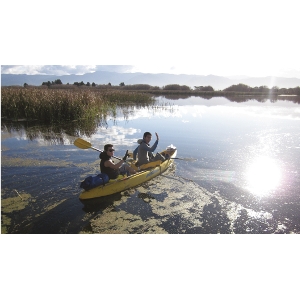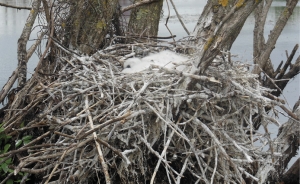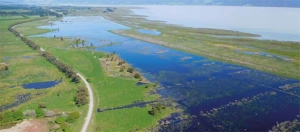Displaying items by tag: Boggy Pond
Hydrological and chemical characteristics of Matthews Lagoon and Boggy Pond, Wairarapa
Essential information for the decision making process of wetland restoration.
Wetlands are areas where lands transition to water bodies. Because of this special geomorphological setting, wetlands play important roles in flood control, nutrient retention, and water storage. In New Zealand, less than 10 percent of the original wetlands have survived since human settlement. Many of the remaining wetlands are still under threat from water quality degradation, invasive species, and changes in hydrological regime.
Wetland restoration is the process of bringing the structure and function of a wetland back to its original state. Although specific objectives may vary between projects, three major objectives of wetland restoration are restoration of wetland function, restoration of wetland structure, and restoration of traditional landscape and land-use practices. In order to ensure the success of a wetland restoration project, a good understanding of the hydrological process in the wetland is the first step.
Boggy Pond and Matthews Lagoon on the eastern edge of Lake Wairarapa in the Wellington Region were formed as a result of the deposition of sand dunes on the eastern shore and changes in river courses between floods. They were modified by a series of engineering works under the lower Wairarapa valley development scheme in the 1980s.
Boggy Pond is cut off from Lake Wairarapa and surrounding wetlands by a road and stopbank, leaving a more stable water level compared to its original state. To analyse the water and nutrient balance in these two wetlands, factors such as surface flows, surface water levels, groundwater levels, rainfall, climate data, and water quality were assessed at various monitoring stations in this study. It is believed that Matthews Lagoon and Boggy Pond have completely different water regimes. Matthews Lagoon receives surface inflow from the Te Hopai drainage scheme and discharges to Oporua floodway, but Boggy Pond only has rainfall as the water input.
The results from the water balance analysis seem to support this assumption. An unexpected finding in Matthews Lagoon suggests that water might bypass the main wetland, creating a shortcut between the inlet and outlet. As a result, the nutrient removal ability was considerably weakened by this bypass because of the short water retention time.
In Boggy Pond, there may be an unknown water input which could adversely affect the
Some recommendations are given on the restoration of these two wetlands. First, set proper objectives according to their different functions. Second, enhance the nutrient removal ability of Matthews Lagoon by harvesting plants, removing old sediments, and creating a more evenly distributed flow across the wetland throughout the year. Third, restore the natural water level fluctuations and improve water quality in Boggy Pond by identifying any unknown water inputs first.
To view Cheng Shi’s full thesis go to:http://researcharchive.vuw.ac.nz/
Boggy Pond April rounds
Keeping count at Boggy
Steve Playle completed two years of trapping at Boggy wetlands at the end of June this year.
He sent the following report:
Interestingly predator numbers have not reduced since the first year off trapping was completed. There is currently 94 trapping sites established around the project area now so trapping hours have increased substantially meaning that more traps have been available for predators to encounter than was the case in the first year.
| Trapping Period | Cats | Ferrets | Stoats | Weasels | Rats | Hedgehogs | Mice | magpies | Hawks | Rabbits |
| 2014/2015 | 20 | 60 | 2 | 18 | 87; | 169 | 70 | 10 | 11 | 4 |
| 2013/2014 | 20 | 43 | 1 | 13 | 52 | 159 | 29 | 10 | 2 | 1 |
| Over 2 years | 40 | 103 | 3 | 31 | 139 | 328 | 99 | 20 | 13 | 5 |
Steve Playle
Biosecurity Officer
Spoonbills at Boggy Pond and surrounds
The photo is of spoonbill chicks in a nest early this year. The nest itself is a pretty loose affair of sticks placed in the base of a dead willow tree and surrounded by open water on all sides. As the chicks age the nest becomes a lot whiter, the result of droppings from both the chicks and their parents.
This was the first record of spoonbills nesting at Boggy Pond and only the second for Wairarapa.
They have been seen more often in the wider area over the past few years with the increased area of shallow wetland created by DU’s Wairio restoration project likely to be providing a good reliable food source.
I think, also, that the predator control in the area has been a big part of supporting these nests once they start and giving the youngsters a decent chance of fledging.
We hope that this is the first of many!
Earlier in the year a team took the canoe to chase and spray purple loosestrife.
On the way out we noted a big flock of spoonbills at the northern end of the lagoon and on the way back we came across some nests in the bases of sprayed willows.
We didn’t approach too closely, but through the telephoto it looked like two chicks at least in each.
It was quite a shock to come across these, a pleasant one too, as you’d imagine. This is the second confirmed nesting site at Wairarapa Moana.
We plan to follow up the loosestrife work and will check on these chicks and have a look over a wider area to see if there are more.
I think this is a result of the combination of willow spraying opening up the lagoon and creating the right conditions for nest building and the pest control keeping the nests alive instead of providing food for hungry mammals.
Tony Silbery
Kaiarahi- Koiora Rereketanga (Ranger, biodiversity) DoC.
Hard Work at Boggy Pond
- 62 cats,
- 140 ferrets,
- 8 stoats,
- 53 weasels,
- 652 hedgehogs and
- 295 rats.



